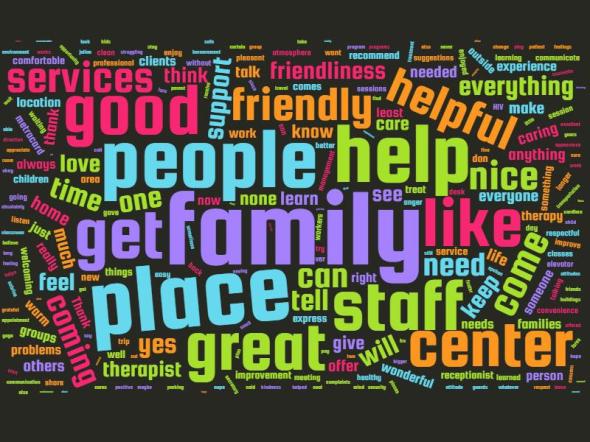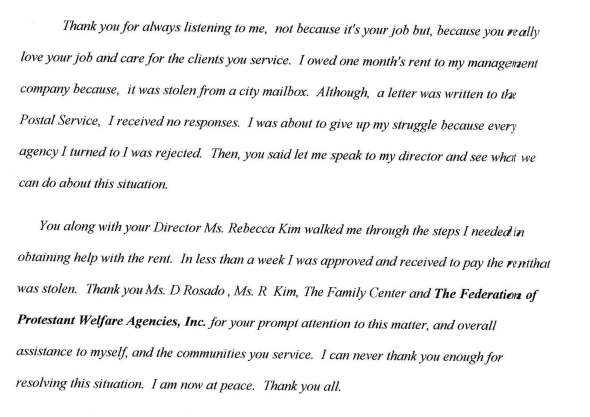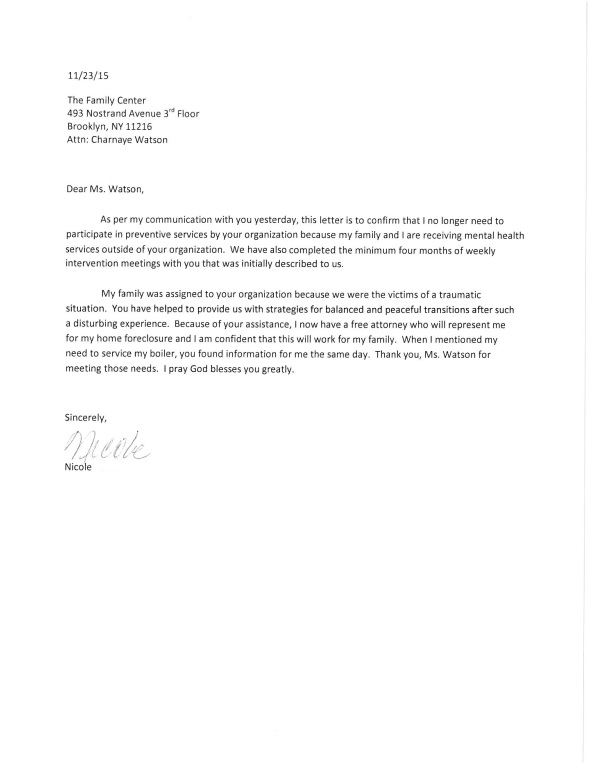Portrait of A Family Center Attorney
Posted: February 20, 2017 Filed under: Our Cherished Children & Families, Our Legal Lifeline, Uncategorized 8 Comments This drawing was done by one of our client’s children a few years ago. The drawing is of Legal Wellness Institute (LWI) Assistant Director Caroline Bersak and the client’s artistic talents are obviously impressive. Caroline exclaimed,
This drawing was done by one of our client’s children a few years ago. The drawing is of Legal Wellness Institute (LWI) Assistant Director Caroline Bersak and the client’s artistic talents are obviously impressive. Caroline exclaimed,
“That is the exact outfit I was wearing and how I had my hair that day!”
Caroline and her colleagues were representing the client in family court to adopt her step-daughter, whose biological parents are both deceased. Our client brought the kids with her one day when she and Caroline met; The Family Center, of course, had materials on-hand to keep the children entertained.
This drawing has been hanging on the bulletin board over Caroline’s desk for the past few years. Caroline asserts,
“It makes me happy every time I see it.”
The adoption of this client’s stepdaughter (now daughter) was finalized in November 2016.
The Family Center LWI provides legal services and representation to thousands of New York City families every year. While this portrait of Caroline makes her happy, one can only wonder: how happy the child who drew it was, how happy her sibling who was adopted is, and how thrilled their caregiver was to have expert legal support in the adoption matter. All in a day’s work for LWI!
Two Words
Posted: July 7, 2016 Filed under: Our Cherished Children & Families, Our Legal Lifeline | Tags: #thankful, rewarding moments, true impact Leave a comment Clients come to the Legal Wellness Institute (LWI) during some of the most challenging periods in their lives. When they arrive at our office, they are struggling with illness, loss and the uncertainty of legal proceedings. Although it is the last thing any of us would expect, LWI clients always find a way to say thank you for our work.
Clients come to the Legal Wellness Institute (LWI) during some of the most challenging periods in their lives. When they arrive at our office, they are struggling with illness, loss and the uncertainty of legal proceedings. Although it is the last thing any of us would expect, LWI clients always find a way to say thank you for our work.
Yesterday, our legal services coordinator, Jonathan Riedel and one of our legal interns, Ellen Degnan, received a noteworthy thank you. It was from a client with whom they had been working with on an administrative agency dispute. After weeks of diligent effort, they secured a favorable decision without the client having to go to a hearing. As you can see, the client was delighted with the outcome.

Ellen and Jonathan with their sweet thank you from a grateful LWI client.
Ellen said, “Receiving this gift filled me with joy because it offered a glimpse of our client’s joy, her relief, even days after we celebrated the good news together. There is no better feeling.”
LWI is thankful for the opportunity to do work that matters and frequently, for the gratitude of our clients. Of course, we never ask for a thank you, but those two words are always nice to hear.
What Our Clients Are Saying
Posted: February 17, 2016 Filed under: Executive Director's Corner, Our Cherished Children & Families Leave a commentIn early December of 2015, 116 of our clients completed a satisfaction survey and gave high scores (4 out of a total score of 5) on different areas such as: cleanliness, comfort, safety, and appearance of The Family Center’s facilities, as well as the helpfulness and friendliness of staff. Clients were also asked to talk about their experience coming to The Family Center, specifically what they liked vs. disliked, and if they would recommend our services to others in their family or community. People commented on how comfortable they are coming to The Family Center, how supportive and great our staff are, and expressed having an overall pleasant feeling at our office in Brooklyn.
In order to better demonstrate what clients said about The Family Center, a word cloud was created using the written statements from the satisfaction survey. This word cloud shown below is a graphical representation of a word count where the size of the word directly relates to the number of times the word was used. Looking at this word cloud, you get a sense that people talked a lot about our services, our helpfulness, and friendliness, as well as the good people at The Family Center and what a great place it is. Interestingly, the word “Family” is the largest word, and the word “center” also appears in this word cloud, demonstrating that clients talked about The Family Center as a whole, but also mentioned their family, or families in general, a great deal since the word is larger than the word “center.” The Family Center learned a great deal from the feedback we received from our clients. We hope to continue bringing exceptional services and care to the New York City community and our clients.

-Casey Castro, Family Center Research Coordinator
Buddy Pair Share More Than Love of Movies
Posted: January 26, 2016 Filed under: Our Cherished Children & Families, Visionary Volunteer Leave a commentDevin, now 12 years-old, and I have been together for three years. Since that time, his grades have improved greatly. Our favorite hang-out is the AMC West 84th Street movie theater. One can find us relaxing there in the plush, bright red reclinging chiars.
 Devin is an avid Giants fan and his favorite player is Victor Cruz. Thanks to Leah, the Director of Strategic Philthropy at Time Warner Cable, we were able to attend a fundraiser as special guests and meet Devin idol, Cruz.
Devin is an avid Giants fan and his favorite player is Victor Cruz. Thanks to Leah, the Director of Strategic Philthropy at Time Warner Cable, we were able to attend a fundraiser as special guests and meet Devin idol, Cruz.
My mother passed away last year in July. I observed a sense of maturity in Devin following that experience. Although we seldom talk about it -when we met three years ago, he had previously lost his own mother. It’s cool because we can related due to this shared space.
Sincerely,
Everett, mentor to Devin in The Buddy Program
HIV by the Numbers
Posted: December 1, 2015 Filed under: Our Cherished Children & Families, Our Legal Lifeline Leave a comment For over twenty years, The Family Center’s attorneys have represented thousands of HIV-positive New Yorkers, resolving issues relating to housing, health care, income, benefits, family law, and planning for their future. Almost everything about HIV has changed during this time. The number of infections has changed. The number of those living with it has changed. The drugs have changed. The life expectancy has changed. We used to describe HIV as a death sentence. Now, we talk about HIV as “treatable” or as being a “chronic illness.”
For over twenty years, The Family Center’s attorneys have represented thousands of HIV-positive New Yorkers, resolving issues relating to housing, health care, income, benefits, family law, and planning for their future. Almost everything about HIV has changed during this time. The number of infections has changed. The number of those living with it has changed. The drugs have changed. The life expectancy has changed. We used to describe HIV as a death sentence. Now, we talk about HIV as “treatable” or as being a “chronic illness.”
On this World AIDS Day, we’ll see plenty of numbers describing the HIV epidemic and the progress we’ve made. This progress is worth celebrating. But there is still much work to be done. Too many people with HIV struggle with additional challenges, including mental illness, poverty, and instability. The numbers that describe their stories show how much we have yet to accomplish in our fight against HIV. Below, we run through some of these numbers for one of our clients, Kevin. His name was changed to protect his privacy, but the numbers are all real.
| 1990 | Year Kevin was born. |
| 0 | Age at which Kevin was diagnosed with HIV. He was born positive. |
| 9 | Age at which Kevin was diagnosed with mental illness. He is currently treated for bipolar disorder and schizophrenia. |
| 10 | Highest grade that Kevin completed in high school. Despite special education services, including homeschooling, Kevin was not able to graduate. |
| 18 | Age at which Kevin first attempted to work, as a dishwasher in a restaurant. The environment exacerbated his illnesses so he had to stop working after a few weeks. He has not been able to work since then. |
| 25 | Years Kevin has taken antiretroviral medications to control his HIV infection. |
| 80 | Routine health care appointments Kevin has each year, not including acute care visits or hospitalizations. |
| 5 | Minimum number of medications Kevin takes each day. |
| 12 | Symptoms and side effects Kevin experiences weekly due to his HIV and antiretroviral drugs, including: skin rashes, weight loss, swelling, weakness, numbness, bruising, vomiting, dizziness, shortness of breath, stomach cramping, exhaustion, and hypertension. |
| 37,064 | Copies of the HIV virus found in one milliliter of Kevin’s blood, as measured by his most recent lab test (his “viral load”). When HIV medications work properly, the viral load should drop to a level that is undetectable. |
| 216 | Kevin’s most recent CD4 count, which measures infection-fighting white blood cells. A healthy person should have a CD4 count of 500 or more. Anything below 200 means that a person with HIV has progressed to AIDS status. |
| 6 | Months Kevin was homeless after his mother, who has a history of substance abuse and mental illness, kicked him out in 2014. During this time, Kevin slept on the street or in the hallways of apartment buildings. |
| 3 | Times Kevin has attempted suicide. |
| 3 | Times Kevin applied for Public Assistance and Supplemental Nutrition Assistance benefits before his application was finally approved. |
| 4 | Average number of appointments Kevin had to attend each time he applied for these benefits. |
| 2 | Administrative hearings required to correct mistakes made by the welfare agency in processing Kevin’s benefit applications. |
| 183 | Monthly amount, in dollars, Kevin received in Public Assistance benefits once he was finally approved. Before this, Kevin had no income. |
| 13 | Months Kevin had to wait for an administrative hearing after he appealed the denial of his application for Supplemental Security Income (SSI), a form of Social Security benefits for people who are disabled and low-income. |
| 646 | Pages of medical records that Kevin’s Family Center attorney obtained and reviewed in preparation for Kevin’s SSI appeal hearing. |
| 5 | Months it took for an Administrative Law Judge to issue a decision after this hearing. The judge found that Kevin was disabled and should have been approved for SSI benefits. |
| 1.75 | Years Kevin has been working with an attorney to resolve the issues relating to his benefits. |
| 733 | Dollars per month that Kevin now receives in Supplemental Security Income. |
| 450 | Dollars per month Kevin now pays to rent a room in the apartment of a family friend. |
| 1 | Years Kevin has had stable housing since he can now afford to rent a room. |
| 79,386 | Amount by which Kevin’s HIV Viral Load has decreased since January 2014. |
| 0 | Times Kevin has been hospitalized since he has had income and stable housing. |
| 0 | Times Kevin has attempted suicide since he had income and stable housing. |
Kevin’s experience is by no means unique or unusual. We see hundreds of clients with numbers just like these every year. As a society, we’ve come a long way in our fight against HIV and AIDS, but there’s still a long way to go. Not just with medicine, but with ensuring adequate housing, income, health care, and support. A person who is poor and sick shouldn’t need an attorney to access the safety net benefits that exist to support them. But until that’s the case, The Family Center will continue our work to bring stability and to improve the numbers for Kevin and all those like him.
By Caroline L. Bersak, Esq., Assistant Director of Legal Services
Thanksgiving by Numbers
Posted: November 24, 2015 Filed under: Our Cherished Children & Families, Our Legal Lifeline Leave a commentAs the holiday season begins, so too will the many stories and statistics that have become synonymous with this time of year. How many Americans shopped on Black Friday and what did they buy? How many people travelled on Thanksgiving? How many turkeys did Americans consume this season? Which one did the President pardon? In an era defined by rapid information sharing, numbers say a lot, even about our celebrations.
One number not often reported is how much a celebration like Thanksgiving costs. According to the American Farm Bureau Federation, the cost of Thanksgiving dinner in 2014 for ten people was $49.41. The price has remained about $49 since 2011. If costs hold steady, you can expect to spend just under $5.00 per person this year. This is an average; most people spend much more than $5.00.
Five dollars doesn’t sound like a lot until you consider that many people buy food with food stamps. The Supplemental Nutrition Assistance Program (SNAP), as food stamps are formally known, is a government program that helps struggling families afford food. Although the economy has improved since the recession, many people still live day-to-day and still use SNAP. Moreover, the number of people on SNAP benefits has gone up considerably, from an average of 26.3 million in 2007 to 46.5 million in 2014.
Chances are that you know someone on SNAP. Working people, two-income households and maybe most appalling -soldiers and their families receive SNAP benefits. What this means is that you can work very hard, serve your country and still not have enough money to put food in your refrigerator. The formula to calculate SNAP is complex, but generally, your income has to be very low.
How low? To put this into perspective, let’s consider a family of four where the father (Sam) earns a respectable $15.00 an hour and the mother (Jane) cares for their two children . They pay $800 for a two bedroom apartment plus utilities. If they applied for SNAP tomorrow, they would get $304 a month in benefits for food. In fact, the way the SNAP formula works, this is the maximum amount they can receive.
Still, $304 a month sounds like a nice addition to anyone’s total income, until you think about it. Jane and Sam spend all of their SNAP and all the rest of their non-rent income only on food, with no money allotted for anything else including transportation.
Using every dollar they have to pay for rent and food, leaves them with $4.04 to spend per person per meal. Do you remember the last time you spent $4.00 per person…for anything?
This family is lucky. Sam makes 170% of the minimum wage. This hypothetical (which is based on a real client of our non-profit) assumes a very low rent and utilities of no more than $64 a month. It does not include the taxes taken out of Sam’s paycheck. It assumes that Sam works and is not disabled, that his job is stable, that there are no emergencies. Everything has to remain artificially cheap and all life events must go their way. Any setback means they have to make a choice between eating or not.
If Sam made just a little more, say $17.50 an hour, or if both parents worked minimum wage jobs while grandmother babysat, the family would be disqualified from SNAP altogether because they would have too much money and still very little.
Policymakers often state that they believe in caring for the poor, but the laws they have proposed, enacted, or failed to enact suggest the opposite. Congress’ bipolarity cannot be blamed; it’s simply that nobody is galvanized by benefit increases for the working poor. Some have recently been given to shaming the poor by regulating what they eat or highlighting especially egregious cases of fraud, waste, or abuse. While others have weakly defended against unfair claims, mostly politicians just ignore the problem entirely. No politician at the federal level has seriously attempted to garner support for a bill that increases the allotment of SNAP to a level that actually sustains a household’s need for food.
Both sides do not acknowledge just how inadequate this part of our safety net really is. We all acknowledge that with 45 million people in the U.S. receiving SNAP, the number of people who need public assistance benefits to eat is too high. What we give them through tax dollars is hardly enough. Congress has stated through many of its policies that America is willing to abandon some populations – the undocumented, people with severe mental health problems, and others. But what about the United States Citizen and Army veteran who now works full time? What if he has a wife and kids to support?
There’s nothing wrong with big celebrations. Still, when you sit down to your Thanksgiving meal next week, remember the 45 million Americans who cannot afford a turkey with trimmings or anything close to it. Here is just one of many ideas for you and your family that can make things just a little easier for those who are spending six dollars or less per person this Thanksgiving because that’s all they can afford.
Even better, spend six dollars per person this year and give the difference in your budget to a charity. Try it as an experiment.
Maybe if enough of us do it, we may hear it reported as a new holiday statistic.



 On the night of Saturday June 11th, I was with friends celebrating Brooklyn Pride. Sunday morning I learned that there had been a mass shooting in Orlando. It wasn’t until Monday that I was able to process what was happening. An LGBTQIA nightclub was attacked by one person with an assault rifle at the same time I had been at an LGBTQIA event. The underlying implications of this event became very real to me. “It could have been the party I was attending if I were visiting Orlando, or if the shooter lived in New York City.” I realized that I wasn’t the only person to come to this feeling of being unsafe when friends began to state they were not going to New York City pride events because of the looming unknown.
On the night of Saturday June 11th, I was with friends celebrating Brooklyn Pride. Sunday morning I learned that there had been a mass shooting in Orlando. It wasn’t until Monday that I was able to process what was happening. An LGBTQIA nightclub was attacked by one person with an assault rifle at the same time I had been at an LGBTQIA event. The underlying implications of this event became very real to me. “It could have been the party I was attending if I were visiting Orlando, or if the shooter lived in New York City.” I realized that I wasn’t the only person to come to this feeling of being unsafe when friends began to state they were not going to New York City pride events because of the looming unknown. Back at work that week I talked to my colleagues about the fear I was feeling and I was encouraged to think of my clients that have experienced trauma and the effect this incident may be having on them. So, I checked in with my clients who have identified the LGBTQIA community as one they belonged to, and I heard story after story of times that living out loud made them feel unsafe as well as about times that it felt empowering. I encouraged my clients to have compassion for themselves in the coming weeks, and only do and read what felt good. And I decided to practice what I preached.
Back at work that week I talked to my colleagues about the fear I was feeling and I was encouraged to think of my clients that have experienced trauma and the effect this incident may be having on them. So, I checked in with my clients who have identified the LGBTQIA community as one they belonged to, and I heard story after story of times that living out loud made them feel unsafe as well as about times that it felt empowering. I encouraged my clients to have compassion for themselves in the coming weeks, and only do and read what felt good. And I decided to practice what I preached. Here at TFC we share experiences with clients every day and use the space that we have to encourage a sense of calm, peace and safety. I am excited to continue to offer our space to build a safe and caring community to all people by beginning a monthly dinner series for our clients and members of our community that identify as LGBTQIA. We welcome LGBTQIA individuals and families to join us in resisting hate with joy and compassion. The safety I felt at the parade came from being completely myself and having people not just tolerate it, but celebrate it. And if I can offer a little bit of that feeling to our clients I will always choose to do so. If you are a current TFC client and are interested in participating in the dinner series, please contact me at
Here at TFC we share experiences with clients every day and use the space that we have to encourage a sense of calm, peace and safety. I am excited to continue to offer our space to build a safe and caring community to all people by beginning a monthly dinner series for our clients and members of our community that identify as LGBTQIA. We welcome LGBTQIA individuals and families to join us in resisting hate with joy and compassion. The safety I felt at the parade came from being completely myself and having people not just tolerate it, but celebrate it. And if I can offer a little bit of that feeling to our clients I will always choose to do so. If you are a current TFC client and are interested in participating in the dinner series, please contact me at 
